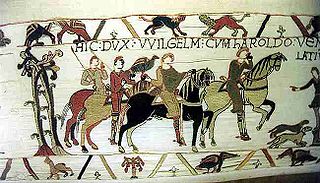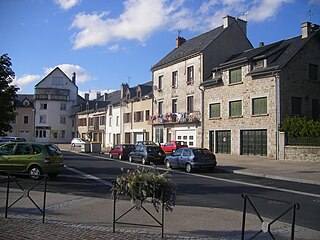

The Wolf of Ansbach was a man-eating wolf that attacked and killed an unknown number of people in the Principality of Ansbach in 1685, then a part of the Holy Roman Empire. [1]


The Wolf of Ansbach was a man-eating wolf that attacked and killed an unknown number of people in the Principality of Ansbach in 1685, then a part of the Holy Roman Empire. [1]
Initially a nuisance preying on livestock, the wolf soon began attacking children. The citizens of Ansbach believed the animal to be a werewolf, a reincarnation of their late and cruel Bürgermeister Michael Leicht, whose recent death had gone unlamented. During an organized hunt, the locals succeeded in driving the wolf from a nearby forest and chasing it down with dogs until it leaped into an uncovered well for protection. Trapped, the wolf was slain, and its carcass paraded through the city marketplace. It was dressed in a man's clothing and, after severing its muzzle, the crowd placed a mask, wig, and beard upon its head, giving it the appearance of the former Bürgermeister. The wolf's body was then hanged from a gibbet for all to see until it underwent preservation for permanent display at a local museum. [2]
Franz Ritter von Kobell and other writers wrote poems about the wolf and its actions. [3]

Ansbach is a city in the German state of Bavaria. It is the capital of the administrative region of Middle Franconia. Ansbach is 40 kilometers southwest of Nuremberg and 140 kilometers north of Munich, on the river Fränkische Rezat, a tributary of the river Main. In 2020, its population was 41,681.

The wolf, also known as the gray wolf or grey wolf, is a canine native to Eurasia and North America. More than thirty subspecies of Canis lupus have been recognized, including the dog and dingo, though gray wolves, as popularly understood, only comprise naturally-occurring wild subspecies. The wolf is the largest wild extant member of the family Canidae, and is further distinguished from other Canis species by its less pointed ears and muzzle, as well as a shorter torso and a longer tail. The wolf is nonetheless related closely enough to smaller Canis species, such as the coyote and the golden jackal, to produce fertile hybrids with them. The wolf's fur is usually mottled white, brown, gray, and black, although subspecies in the arctic region may be nearly all white.

In folklore, a werewolf, or occasionally lycanthrope, is an individual who can shape-shift into a wolf, or especially in modern film, a therianthropic hybrid wolf-like creature, either purposely or after being placed under a curse or affliction, often a bite or the occasional scratch from another werewolf, with the transformations occurring on the night of a full moon. Early sources for belief in this ability or affliction, called lycanthropy, are Petronius (27–66) and Gervase of Tilbury (1150–1228).

Paul Johann Ludwig von Heyse was a German writer and translator. A member of two important literary societies, the Tunnel über der Spree in Berlin and Die Krokodile in Munich, he wrote novels, poetry, 177 short stories, and about sixty dramas. The sum of Heyse's many and varied productions made him a dominant figure among German men of letters. He was awarded the 1910 Nobel Prize in Literature "as a tribute to the consummate artistry, permeated with idealism, which he has demonstrated during his long productive career as a lyric poet, dramatist, novelist and writer of world-renowned short stories." Wirsen, one of the Nobel judges, said that "Germany has not had a greater literary genius since Goethe." Heyse is the fifth oldest laureate in literature, after Alice Munro, Jaroslav Seifert, Theodor Mommsen and Doris Lessing.

Wolfgang Xavier Franz Ritter von Kobell was a German mineralogist and writer of short stories and poems in Bavarian dialect.

Armin Mueller-Stahl is a retired German actor who also appeared in numerous English-language films since the 1980s. He was nominated for the Academy Award for Best Supporting Actor for his role in Shine. In 2011, he was awarded the Honorary Golden Bear.

Brotherhood of the Wolf is a 2001 French period action horror film directed by Christophe Gans, co-written by Gans and Stéphane Cabel, and starring Samuel Le Bihan, Mark Dacascos, Émilie Dequenne, Monica Bellucci and Vincent Cassel. The story takes place in 18th-century France, where the Chevalier de Fronsac and Mani of the Iroquois tribe are sent to investigate the mysterious slaughter of hundreds by an unknown creature in the county of Gévaudan.

The Beast of Gévaudan is the historic name associated with a man-eating animal or animals that terrorized the former province of Gévaudan, in the Margeride Mountains of south-central France between 1764 and 1767.

Royal hunting, also royal art of hunting, was a hunting practice of the aristocracy throughout the known world in the Middle Ages, from Europe to Far East. While humans hunted wild animals since time immemorial, and all classes engaged in hunting as an important source of food and at times the principal source of nutrition, the necessity of hunting was transformed into a stylized pastime of the aristocracy. In Europe in the High Middle Ages the practice was widespread.

Wolf hunting is the practice of hunting wolves. Wolves are mainly hunted for sport, for their skins, to protect livestock and, in some rare cases, to protect humans. Wolves have been actively hunted since 8,000 to 10,000 years ago, when they first began to pose a threat to livestock of Neolithic human communities. Historically, the hunting of wolves was a huge capital- and manpower-intensive operation. The threat wolves posed to both livestock and people was considered significant enough to warrant the conscription of whole villages under threat of punishment, despite the disruption of economic activities and reduced taxes. The hunting of gray wolves, while originally actively endorsed in many countries, has become a controversial issue across the globe. Most people see it as cruel, unnecessary and based on misconceptions, while proponents argue that it is vital for the conservation of game herds and as pest control.
François Antoine, Officer of the Royal Bedchamber, Knight Equerry of the Royal Military Order of Saint Louis, served as Gun-Bearer to the King and Lieutenant of the Hunt under Louis XV of France, and is most notable as having pursued and slain what was thought to be the Beast of Gévaudan, its mate, and its whelps between 23 June and 17 October 1765.

The Eurasian wolf, also known as the common wolf, is a subspecies of grey wolf native to Europe and Asia. It was once widespread throughout Eurasia prior to the Middle Ages. Aside from an extensive paleontological record, Indo-European languages typically have several words for "wolf", thus attesting to the animal's abundance and cultural significance. It was held in high regard in Baltic, Celtic, Slavic, Turkic, ancient Greek, Roman, Dacian, and Thracian cultures, whilst having an ambivalent reputation in early Germanic cultures.

Villefranche XIII Aveyron is a semi-professional rugby league club based in Villefranche-de-Rouergue, Aveyron in southern France. Formed in 1950, they currently play in the Super XIII. Their home stadium is currently the Stade Henri Lagarde.

Saint-Chély-d'Apcher is a commune in the Lozère department in southern France.

The Wolf Leader is an English translation by Alfred Allinson of Le Meneur de loups, an 1857 dark fantasy novel by Alexandre Dumas. Allinson's translation was first published in London by Methuen in 1904 under the title The Wolf-Leader; the first American edition, edited and somewhat cut by L. Sprague de Camp and illustrated by Mahlon Blaine, was issued under the present title by Prime Press in 1950. The text was also serialized in eight parts in the pulp magazine Weird Tales in the issues for August 1931 to March 1932.

Wolf attacks are injuries to humans or their property by gray wolves. Their frequency varies with geographical location and historical period, but overall wolf attacks are rare. Wolves today tend to live mostly far from people or have developed the tendency and ability to avoid them. Experts categorize wolf attacks into various types, including rabies-infected, predatory, agonistic, and defensive.
The Wolf of Soissons was a man-eating wolf which terrorized the commune of Soissons northeast of Paris over a period of two days in 1765, attacking eighteen people, four of whom died from their wounds.
The Wolves of Hazaribagh were a pack of five man-eating Indian wolves which between February and August 1981, killed 13 children aged from 4 to 10 years. Their hunting range was 2.7 square miles around the town of Hazaribagh in the eastern Indian district of Bihar. They were apparently attracted to the area by the town's rubbish dump, where livestock carcasses and bodies from the local mortuary were often buried, and frequently attracted wolves, striped hyenas, golden jackals and pariah dogs.
In Bavarian folklore of the Early Modern period, a Wolfssegen was an apotropaic charm against wolves; conversely, a Wolfbann (Wolf-Bann) was a malevolent spell causing a wolf attack.

On 24 July 2016, fifteen people were injured, four seriously, in a suicide bombing outside a wine bar in Ansbach, Bavaria, Germany. The bomber, identified by police as Mohammad Daleel, was a 27-year-old Syrian asylum seeker who had pledged allegiance to Abu Bakr al-Baghdadi, leader of the Islamic State. He was the only fatality in the incident. According to German authorities, Daleel was in contact with the Islamic State and had been planning more attacks before his backpack bomb exploded accidentally.